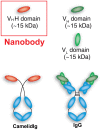Nanobody: the "magic bullet" for molecular imaging?
- PMID: 24578722
- PMCID: PMC3936291
- DOI: 10.7150/thno.8006
Nanobody: the "magic bullet" for molecular imaging?
Abstract
Molecular imaging involves the non-invasive investigation of biological processes in vivo at the cellular and molecular level, which can play diverse roles in better understanding and treatment of various diseases. Recently, single domain antigen-binding fragments known as 'nanobodies' were bioengineered and tested for molecular imaging applications. Small molecular size (~15 kDa) and suitable configuration of the complementarity determining regions (CDRs) of nanobodies offer many desirable features suitable for imaging applications, such as rapid targeting and fast blood clearance, high solubility, high stability, easy cloning, modular nature, and the capability of binding to cavities and difficult-to-access antigens. Using nanobody-based probes, several imaging techniques such as radionuclide-based, optical and ultrasound have been employed for visualization of target expression in various disease models. This review summarizes the recent developments in the use of nanobody-based probes for molecular imaging applications. The preclinical data reported to date are quite promising, and it is expected that nanobody-based molecular imaging agents will play an important role in the diagnosis and management of various diseases.
Keywords: Nanobody; arthritis; atherosclerosis; cancer; molecular imaging; positron emission tomography (PET).
Conflict of interest statement
Competing Interests: The authors have declared that no competing interest exists.
Figures





References
Publication types
MeSH terms
Substances
Grants and funding
LinkOut - more resources
Full Text Sources
Other Literature Sources

